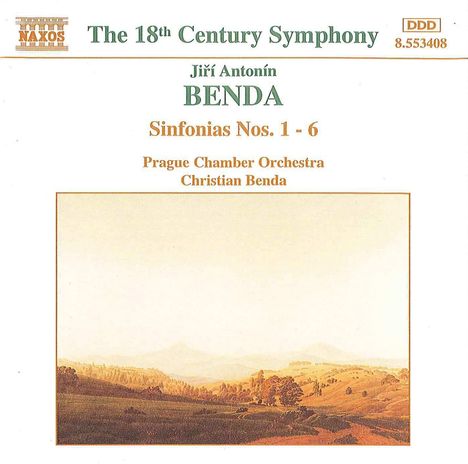Georg Anton Benda: Symphonien Nr.1-6 auf CD
Symphonien Nr.1-6
Herkömmliche CD, die mit allen CD-Playern und Computerlaufwerken, aber auch mit den meisten SACD- oder Multiplayern abspielbar ist.
(soweit verfügbar beim Lieferanten)
- Künstler:
- Prague Chamber Orchestra, Christian Benda
- Label:
- Naxos
- Aufnahmejahr ca.:
- 1995
- Artikelnummer:
- 7542143
- UPC/EAN:
- 0730099440820
- Erscheinungstermin:
- 14.9.1995
- Serie:
- Naxos 18th Century Classics
Die zwölf Sinfonien, die nicht als Sammlung veröffentlicht wurden, sind alle dreisätzig, entwickelt nach dem Potsdamer Stil der Brüder Graun. Die Sinfonia Nr. 1 in D-Dur beginnt mit charakteristischem Schwung, geht dann in einen langsamen Satz in Moll über, dessen Thema durch Zupftöne unterbrochen wird. Jede vorübergehende Melancholie wird in einem schnellen Finalsatz aufgelöst. Die Hörner nehmen eine gewisse Bedeutung im Anfangsthema der Sinfonia Nr. 2 in G-Dur ein, einem lebhaften Satz, auf den ein bewegtes Moll-Andante folgt. Die Hörner kehren für den letzten Satz mit seinem wiederkehrenden Refrain zurück. Ein energisches Anfangsthema kennzeichnet das energische Allegro der Sinfonia Nr. 3 in C-Dur. Es gibt wieder einen langsamen Satz in Moll, der vom thematischen Material der Violine dominiert wird. Der letzte Satz bringt eine Rückkehr zur Tonart C-Dur in einem soliden rhythmischen Schlussallegro. Die Sinfonia Nr. 4 in F-Dur erregt in ihren ersten Tönen Aufmerksamkeit, gefolgt von Musik der erwarteten Brillanz und Energie. Im Andante kommt eine ergreifende Note in Moll hinzu, die im finalen Allegro aufgelöst wird. Die Sinfonia Nr. 5 in G-Dur hat die zu erwartende energische Einleitung, die die Aufmerksamkeit des Zuhörers auf sich zieht, in einem lebhaften Satz mit den erforderlichen Elementen des thematischen und dynamischen Kontrastes. Es folgt ein Andante molto in Moll, das von einem fröhlichen abschließenden Tempo di Minuet gekrönt wird, in dem eine Flöte für Kontrast sorgt. Die Sinfonia Nr. 6 in Es-Dur zeichnet sich durch die Verwendung einer Solovioline aus, die den ersten und letzten Satz des Allegro-Konzerts in einem Stil gestaltet, der an Mozarts Violinkonzerte von 1775 erinnern soll.
Product Information
The twelve symphonies, not published as a set, are all in three movements, developed from the Potsdam style of the Graun brothers. The Sinfonia No. 1 in D major opens with characteristic panache, proceeding to a minor key slow movement, its theme punctuated by plucked notes. Any passing melancholy is dissipated in a rapid final movement. The horns assume some importance in the opening theme of the Sinfonia No. 2 in G major, a lively movement that is followed by a moving minor key Andante. The horns return for the last movement with its recurrent refrain. An energetic opening theme marks the energetic Allegro of the Sinfonia No. 3 in C major. There is again a minor key slow movement dominated by the violin thematic material. The last movement brings a return to the key of C major in a solidly rhythmic final Allegro. The Sinfonia No. 4 in F major summons attention in its first notes, followed by music of the expected brilliance and energy. A note of poignancy is added in the minor key Andante, dispelled in the final Allegro. The Sinfonia No. 5 in G major has the expected vigorous opening, a call to the attention of the listener, in a lively movement with the necessary elements of thematic and dynamic contrast. A minor key Andante molto follows, capped by a cheerful final Tempo di Minuet to in which a flute adds contrast. Sinfonia No. 6 in E flat major is distinguished by its use of a solo violin, making of the opening and final Allegro concerto movements in a style that must suggest Mozart’s violin concertos of 1775.
Disk 1 von 1 (CD)
-
1 Sinfonia No. 1 in D major: I. Allegro
-
2 Sinfonia No. 1 in D major: II. Andante
-
3 Sinfonia No. 1 In D Major: Iii. Allegro Di Molto
-
4 Sinfonia No. 2 in G major: I. Allegro
-
5 Sinfonia No. 2 in G major: II. Andante
-
6 Sinfonia No. 2 In G Major: Iii. Allegro
-
7 Sinfonia No. 3 in C major: I. Allegro
-
8 Sinfonia No. 3 in C major: II. Andante sempre piano
-
9 Sinfonia No. 3 In C Major: Iii. Allegro
-
10 Sinfonia No. 4 in F major: I. Allegro
-
11 Sinfonia No. 4 in F major: II. Andante
-
12 Sinfonia No. 4 In F Major: Iii. Allegro
-
13 Sinfonia No. 5 in G major: I. Allegro
-
14 Sinfonia No. 5 in G major: II. Andante molto
-
15 Sinfonia No. 5 In G Major: Iii. Tempo Di Minuetto
-
16 Sinfonia No. 6 in E flat major: I. Allegro
-
17 Sinfonia No. 6 in E flat major: II. Andante
-
18 Sinfonia No. 6 In E Flat Major: Iii. Allegro
Mehr von Georg Anton Benda
-
Georg Anton BendaCembalokonzerte in f, F, G & hSuper Audio CDAktueller Preis: EUR 7,99
-
The Age of Extremes - WF Bach / CPE Bach / BendaCDAktueller Preis: EUR 19,99
-
Weimar 1755 - Johann Ernst Bach & Georg Anton BendaCDVorheriger Preis EUR 19,99, reduziert um 0%Aktueller Preis: EUR 14,99
-
Georg Anton BendaCembalosonaten Nr.1-6 (1757)CDAktueller Preis: EUR 19,99








